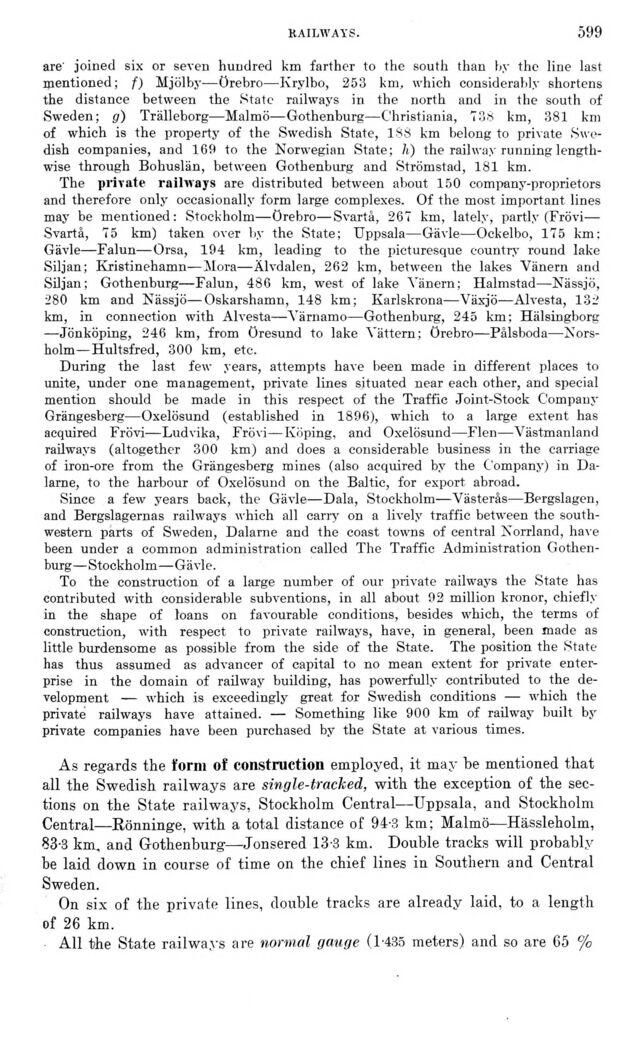
Full resolution (JPEG) - On this page / på denna sida - X. Internal Communications - 1. Railways. By [G. Welin] T. Hamnell

<< prev. page << föreg. sida << >> nästa sida >> next page >>
Below is the raw OCR text
from the above scanned image.
Do you see an error? Proofread the page now!
Här nedan syns maskintolkade texten från faksimilbilden ovan.
Ser du något fel? Korrekturläs sidan nu!
This page has never been proofread. / Denna sida har aldrig korrekturlästs.
railways.
599
are’ joined six or seven hundred km farther to the south than by the line last
mentioned; f) Mjölby—Örebro—Krylbo, 253 km, which considerably shortens
the distance between the State railways in the north and in the south of
Sweden; g) Trälleborg—Malmö—Gothenburg—Christiania, T3S km, 381 km
of which is the property of the Swedish State, 1.8S km belong to private
Swedish companies, and 169 to the Norwegian State; h) the railway running
lengthwise through Bohuslän, between Gothenburg and Strömstad, 181 km.
The private railways are distributed between about 150 company-proprietors
and therefore only occasionally form large complexes. Of the most important lines
may be mentioned: Stockholm—Örebro—Svartå, 267 km, lately, partly (Frövi—
Svartå, 75 km) taken over by the State; Uppsala—Gävle—Ockelbo, 175 km:
Gävle—Falun—Orsa, 194 km, leading to the picturesque country round lake
Siljan; Kristinehamn—Mora—Älvdalen, 262 km, between the lakes Vänern and
Siljan; Gothenburg—Falun, 486 km, west of lake Vänern: Halmstad—Nässjö,
280 km and Nässjö—Oskarshamn, 148 km; Karlskrona—Växjö—Alvesta, 132
km, in connection with Alvesta—Värnamo—Gothenburg, 245 km; Hälsingborg
—Jönköping, 246 km, from Öresund to lake Vättern:
Örebro—Pålsboda—Norsholm— Hultsfred, 300 km, etc.
During the last few years, attempts have been made in different places to
unite, under one management, private lines situated near each other, and special
mention should be made in this respect of the Traffic Joint-Stock Company
Grängesberg—Oxelösund (established in 1896), which to a large extent has
acquired Frövi—Ludvika, Frövi—Köping, and Oxelösund—Flen—Västmanland
railways (altogether 300 km) and does a considerable business in the carriage
of iron-ore from the Grängesberg mines (also acquired by the Company) in
Dalarne, to the harbour of Oxelösund on the Baltic, for export abroad.
Since a few years back, the Gävle—Dala, Stockholm—Västerås—Bergslagen,
and Bergslagernas railways which all carry on a lively traffic between the
southwestern parts of Sweden, Dalarne and the coast towns of central Norrland, have
been under a common administration called The Traffic Administration
Gothenburg—Stockholm—Gävle.
To the construction of a large number of our private railways the State has
contributed with considerable subventions, in all about 92 million kronor, chiefly
in the shape of loans on favourable conditions, besides which, the terms of
construction, with respect to private railways, have, in general, been made as
little burdensome as possible from the side of the State. The position the State
has thus assumed as advancer of capital to no mean extent for private
enterprise in the domain of railway building, has powerfully contributed to the
development — which is exceedingly great for Swedish conditions — which the
private railways have attained. — Something like 900 km of railway built by
private companies have been purchased by the State at various times.
As regards the form of construction employed, it may be mentioned that
all the Swedish railways are single-tracked, with the exception of the
sections on the State railways, Stockholm Central—Uppsala, and Stockholm
Central—Rönninge, with a total distance of 94-3 km; Malmö—Hässleholm,
83-3 km. and Gothenburg—Jonsered 13-3 km. Double tracks will probably
be laid clown in course of time on the chief lines in Southern and Central
Sweden.
On six of the private lines, double tracks are already laid, to a length
of 26 km.
All the State railways are normal gauge (1-435 meters) and so are 65 %
<< prev. page << föreg. sida << >> nästa sida >> next page >>